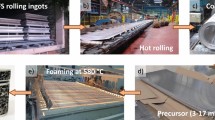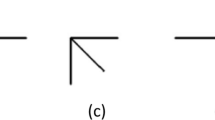Abstract
The efficiency and safety of vehicles represent today one of the most important lines of developing in the automotive industry, for example by the introduction of new materials. In fact, the investment in advanced materials represents one of the most important strategies to reduce injury among vehicle occupants in traffic accidents. Associated with the development of safety systems, there is also the possibility of improving efficiency by the introduction of materials that lead to weight reduction, having a direct impact on fuel consumption and carbon dioxide emissions. Metallic foams are one of these materials, due to the excellent ratio between mechanical properties and density. The main goal of this investigation is to study the mechanical behaviour of aluminium sandwich structures, composed by a metallic foam core with two outer layers of metallic sheets. With this work, the authors intend to contribute to a better understanding and consequently to provide design guidelines for the plastic forming of these composites. In order to correctly characterize the mechanical behaviour of the sandwich structure, the foam core and sheets were tested separately. For the aluminium sheet a series of tensile tests were performed, using samples obtained along three different angles to the rolling direction. For the metal foam core, uniaxial compression tests were used. Finally, with the numerical model defined considering isotropic and anisotropic constitutive models, a set of numerical and experimental bulge tests were performed to evaluate the capacity of forming of these panels, using hydroforming processes.


























Similar content being viewed by others
References
Kleiner M, Geiger M, Klaus A (2003) Manufacturing of lightweight components by Metal Forming. CIRP Ann Manuf Technol 52:521–542
Evans G, Hutchinson JW, Ashby MF (1999) Multifunctional of cellular metal systems. Prog Mater Sci 43:171–221
Baumeister et al (1997) Aluminium foams for transport industry. Mat Design 18:217–220
Miller RE (1998) A continuum plasticity model for the constitutive behaviour of foamed metals. Int. J. Mech. Sci
Deshpande VS, Fleck NA (2000) Isotropic constitutive model for metallic foams. J Mech Phys Solids 48:1253–1276
Gibson LJ, Ashby MF (1997) Cellular Solids. Cambridge University Press, New York
Sugimura Y, Meyer J, He MY, Bart-Smith H, Grenestedt J, Evans AG (1997) On the mechanical performance of closed cell Al alloy foams. Acta Mater 45:5245–5259
Simone AE, Gibson LJ (1998) The effects of cell face curvature and corrugations on the stiffness and strength of metallic foams. Acta Materialia 46:3929–3935
Bart-Smith H, Bastawros AF, Mumm DR, Evans AG, Sypeck DJ, Wadley HNG (1998) Compressive deformation and yielding mechanisms in cellular Al alloys determined using X-ray tomography and surface strain mapping. Acta Materialia 46:3583–3592
Grenestedt JL (1998) Influence of wavy imperfections in cell walls on elastic stiffness of cellular solids. J Mech Phys Solids 46:29–50
Ashby MF et al (2000) Metal foams: a design guide. Butterworth-Heinemann, Oxford
Mata H et al (2011) Analysis of sandwich shells with metallic foam cores based on the uniaxial tensile test. Am Inst Phys AIP 1353:1232
Mata H et al (2011) FEM analysis of sandwich shells with metallic foam cores. Key Eng Mater 473:659–666
Mata H et al (2011) Modeling of sandwich sheets with metallic foam. Am Inst Phys AIP 1383:725
Smith LM et al (2005) NUMISHEET, Proc. 6th Int Conf Num Simulation 3D Sheet Metal Forming Proc., Detroit, USA
Santos AD et al (2006) iddrg’06, Proc Int Deep Drawing Research Group, Porto, Portugal
Ghosh S et al (2004) NUMIFORM, 8th Int Conf Num Methods Industrial Forming Processes, Ohio, USA
Owen DRJ et al. COMPUTATIONAL PLASTICITY VII, Proc 7th Int Conf on Comp Plasticity, Barcelona, Spain
Chinesta F, Cueto E, Advances in Material Forming, ESAFORM 10 years, Springer
Nakagawa T et al (1997) Various applications of hydraulic counter pressure deep drawing. J Mat Process Technol 71:160–167
Technical Data Sheet, Gleich Aluminium (2010)
Neto ES, et al (2008) Computational Methods for Plasticity, John Wiley & Sons Ltd
Mata H et al (2012) Numerical modelling and experimental study of sandwich shells with metal foam cores. Key Eng Mater 473:449–454
Nemat-Nasser S (1979) Decomposition of strain measures and their rates in finite deformation elastoplasticity. Int. J. Solids Struct 15:155–166
von Mises R (1913) Mechanic der Festen Körper in Plastisch Deformablem Zustand, Göttinger Nachr. Math 582
Hill RA (1948) Theory of yielding and plasticity flow of anisotropy metals. Proc R Soc London Ser A-Math Phys Sci 193:281–297
Abaqus, Inc. Abaqus Analysis User’s Manual Version 6.10
Hanssen AG et al (2002) Validation of constitutive models applicable to aluminium foams. Int J Mech Sci 44:359–406
Banhart J, Manufacture (2001) Characterization and application of cellular metals and metal foams. Progress in materials Science 46, 559–632
Miller RE (2000) A continuum plasticity model for the constitutive and indentation behaviour of foamed metals. Int J Mech Sci 42:729–754
McCormack TM et al (2001) Failure of sandwich beams with metallic foam cores. Int J Solids Struct 38:4901–4920
Mata H et al (2011) Numerical and Experimental Study of Sandwich Plates with Metallic Foam Cores, Int Conf on Comp Plasticity, Barcelona, Spain
Barlat F, Lege DJ, Brem JC (1991) A six-component yield function for anisotropic metals. Int J Plast 7:693–712
Barlat F, Chung K, Richmond O (1993) Strain rate potential for metals and its application to minimum plastic work path calculation. Int J Plast 9:1727–1763
Barlat F, Maeda Y, Chung K, Yanagawa M, Brem JC, Hayashida Y, Lege DJ, Matsui K, Murtha SJ, Hattori S, Becker RC, Makosey S (1997) J Mech Phys Solids 45:1727–1763
Chaparro BM, et al (2008) Material parameters identification: Gradient-based, genetic and hybrid optimization algorithms. Computational Materials Science, 44 1
Acknowledgments
The authors truly acknowledge the funding provided by Fundação para a Ciência e a Tecnologia (Portugal), under grant PTDC/EME-TME/098050/2008.
Author information
Authors and Affiliations
Corresponding author
Rights and permissions
About this article
Cite this article
Mata, H., Santos, A.D., Parente, M.P.L. et al. Study on the forming of sandwich shells with closed-cell foam cores. Int J Mater Form 7, 413–424 (2014). https://doi.org/10.1007/s12289-013-1136-9
Received:
Accepted:
Published:
Issue Date:
DOI: https://doi.org/10.1007/s12289-013-1136-9




